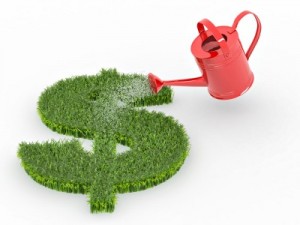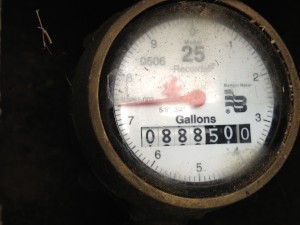How Much Does It Cost: Watering the Lawn
This post will be filed in the “Dad is Learning” folder. It was a HUGE wake up call to me about some wasteful behavior I have been engaged in as a homeowner…
 Over the past few weeks in North Texas we have been blessed with below normal temperatures and a surprising amount of rain for July. The long range forecast shows our temperatures climbing back above 100 degrees and any chance of rain disappearing. Lawns, landscaping, and gardens will all need water to survive, but how much water and how often? I’ll start by taking a look at my setup and then take a look at some cost saving options and ideas for watering the lawn.
Over the past few weeks in North Texas we have been blessed with below normal temperatures and a surprising amount of rain for July. The long range forecast shows our temperatures climbing back above 100 degrees and any chance of rain disappearing. Lawns, landscaping, and gardens will all need water to survive, but how much water and how often? I’ll start by taking a look at my setup and then take a look at some cost saving options and ideas for watering the lawn.
My Lawn
When we built our house in 2007 we had a Bermuda grass lawn hydro-mulched after a sprinkler system was installed. Our property is 1 acre, which is larger than most, but we only water approximately half of it – the front yard and the “play area” out back. We are watering approximately 22,000 sqft of grass which is about double the amount of the average home owner. Here are some numbers I put together to calculate cost:
First I determined the gallons per minute (GPM) that is available to my sprinkler system. I used a 5 gallon bucket and a watch. Quickly turn an outside hose bib on all the way and fill the bucket. Take note of the number of seconds this takes. Divide that number by 5 (or the number of gallons in your bucket) and then multiply by 60. That number is your GPM. My GPM was 7.14. It’s honestly a bit sobering to realize just how quickly water can flow out of your hose.
Another important measurement is the amount of water getting to your grass, also called the precipitation rate. This is an easy experiment that involves 4 empty tuna cans, or something similar. Place the cans in a variety of locations in the zone you want to measure. Turn the sprinkler zone on and let the water run for 10 minutes. At the end of the cycle, collect all 4 cans, combine the water and take a measurement with a ruler. Divide by 4 and you have the average precipitation rate for that zone. We have popup spray heads in our flower beds and around the foundation. The average precipitation rate for those zones is 0.375″ per 10 minutes. We have rotor head zones that water our large grassy areas. The average precipitation rate for those zones is 0.175″ per 10 minutes.
I’m a curious guy so I wanted one more measurement for our system. I assumed the flow rate of our sprinkler system would be similar to the GPM I calculated earlier, but I wanted to double-check since there are other variables involved. To determine GPM through the sprinkler system I noted the water meter reading out front and then turned on some zones on our system to get an average gallons per minute for our various zones. Our popup zones are using 7 GPM and our rotor zones are using 9 GPM. So let’s do some math:
5 popup zones x 15 minutes each x 7 GPM x 2 times a week = 1,050 gallons / week
5 rotor zones x 45 minutes each x 9 GPM x 2 times a week = 4,050 gallons / week
(1,050 GPW + 4,050 GPW) x 4 weeks = 20,400 gallons of water per month
These numbers are worst case scenario if I ran my sprinkler system twice a week, every week, for a month. This month my sprinkler system hasn’t run at all…which is odd for July. BUT…let me say I am simply blown away by how much water we have been pouring onto the lawn. Simply shocked! Many times I have to sit and calculate things like this before they really sink in. I am using 2,550 gallons of water every time I water my lawn. Staggering and disappointing. For comparison, the average pool requires 18,000 to 20,000 gallons of water to fill.
So how much is all this water costing me? The city I live in charges $5.87 cents per 1,000 gallons of water used. Using the current setup, it is costing me $15 every time I water my lawn. The average monthly cost is a worst case scenario month would be $120.
So what should I do to reduce the amount of water I use? I need to make some changes to help my pocketbook and the environment!
Plan of Action
Sprinkler System Audit – A sprinkler system audit is simply a tuneup for your sprinkler system. I am going to have the same company that installed the system come out and fix a few things for me. I know we have some heads that have settled and need some adjusting. Additionally I have hit 3 or 4 popup heads while mowing and replaced them myself. Some of those heads could use either a replacement or some adjusting. Every time we water we have quite a bit of runoff on the driveway. That is quite literally sending money down the drain.
Switch to Manual – Most lawn gurus for the North Texas area suggest keeping your sprinkler system on manual so you are the judge of whether or not your lawn needs water. The exception to this would be if you have a new “smart” system that monitors weather conditions and moisture content. Many of the experts also suggest just watering the zones that need it, instead of using the ‘set it and forget it’ mentality. In my community we are on a twice a week water restriction – we can water on Wednesday and Saturday
Once A Week- I have been using the same watering schedule since our system was installed. It was the recommendation of the man who installed the sprinkler system. Since my lawn is established, I plan to cut back watering to once a week and see what happens. The root system should adapt on a hardy grass like Bermuda. This will save approximately 10,000 gallons of water per month in the most extreme circumstances. Average savings during summer months could be as high as $60 per month.
Long Term Plans – We have talked about planting some trees in our front yard to help shade the house in future years. Trees and other non-grass ground cover can survive on much less water than a yard requires. I could always go to an extreme and anger my neighbors and probably my city by tilling under my lawn and turning it into one big garden.
Other Tips From the Gurus
Neil Sperry recommends mowing your grass at its recommended height all year long. I was always under the impression that it was good to mow the grass a ‘click’ higher with the mower in the summer. The added height can lead to weed issues. The recommended height for a Bermuda lawn like ours is approximately 1.25 to 1.5″.
Texas Smartscape recommends watering once every 7-8 days for Bermuda grass lawns. Watering between 4 a.m. and 6 a.m. is the ideal time to water. Watering in the evening can leave grass wet all night which can promote the growth of certain fungi and diseases.
Concluding Thoughts
I tried to be as transparent as I could with this post. I had NO CLUE I was using SO MUCH water. I am frankly embarrassed to admit I have been so mindlessly wasteful. In this case the money wasn’t the major factor. I simply find it unacceptable to use so much water to have green grass when we live in Texas. At least I’m no where near being on this list.
Have any clue how much water you are using on your lawn? Might be worth checking into. Do you have any tips or suggestions for conserving this valuable resource? If you found today’s post to be thought provoking I would really appreciate you using the share buttons below to send it to friends via email or social media.


Jon, you may consider taking some of that $60 a month and using it to improve your soil condition. Using an organic fertilizer, using compost, and adding rock powders such as lava sand can help hold water for longer periods of time and keep the lawn just as green as you would like. Some golf course supers have recorded using organic technics and receiving a 50% water savings. Rain barrels to collect rain water may also reduce watering in flower beds and garden areas.
These are some great ideas Chris! Thanks for sharing!
Ugh! I hate our water bill! Our yard is about the same size as yours, and we don’t water our front weeds hardly at all, and they still stay green. We do water our shrubs, a portion of our back yard, and those silly fish ponds sometimes require draining and refilling….I hate to see that being done.
Obvious ways to conserve: Water in the early morning before the sun wakes up, some suggest watering once a week, some twice a week. Please don’t water the concrete. Don’t hose off your patio, use a leaf blower, and then sweep if you still need to. Don’t leave your hose faucet on, turn it off at the wall. My husband likes to leave it on at the wall, only to discover a few weeks ago that the hose sprayer was leaking. Oh and Jon, be sure and cook more that one chicken at a time in your stew pot!
Haha…I’ll remember the two per stew pot rule. Everything else was great advice Lisa!
Pingback: Creative DIY Landscaping and Gardening Ideas